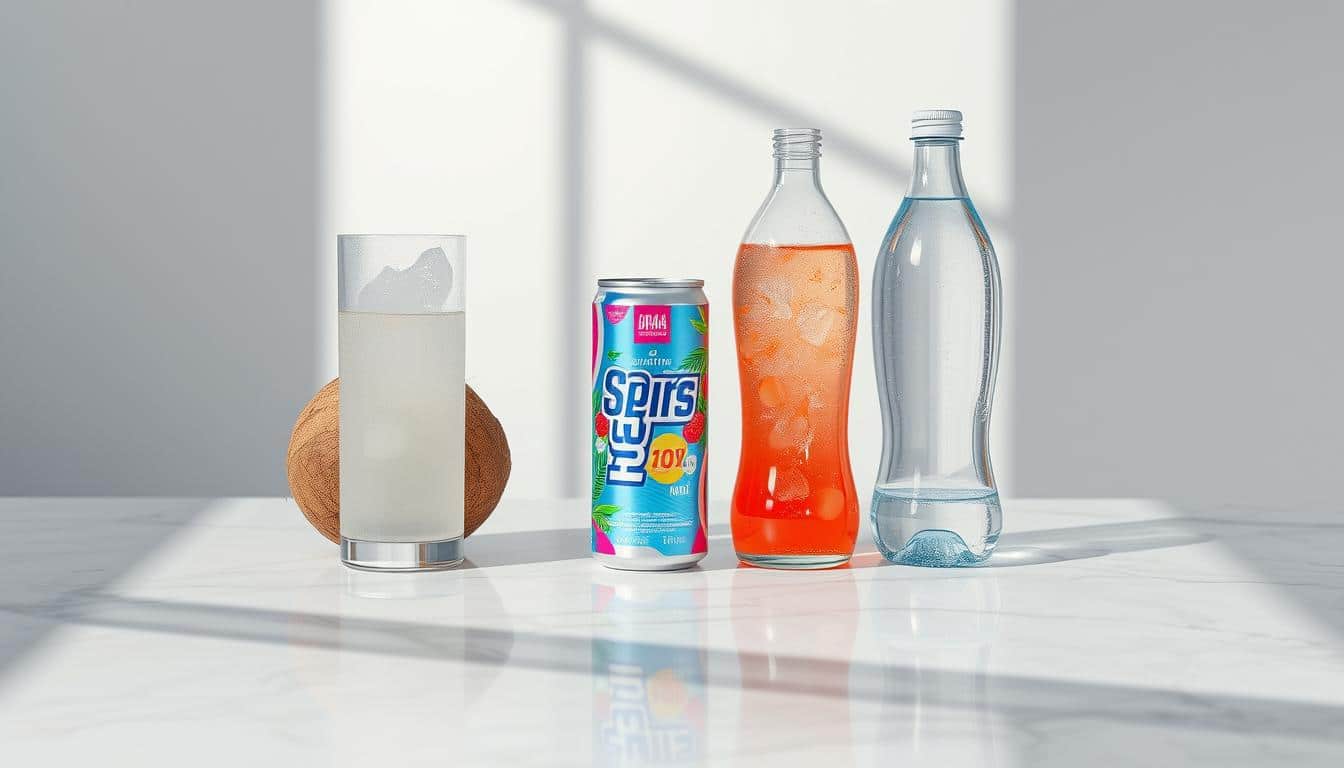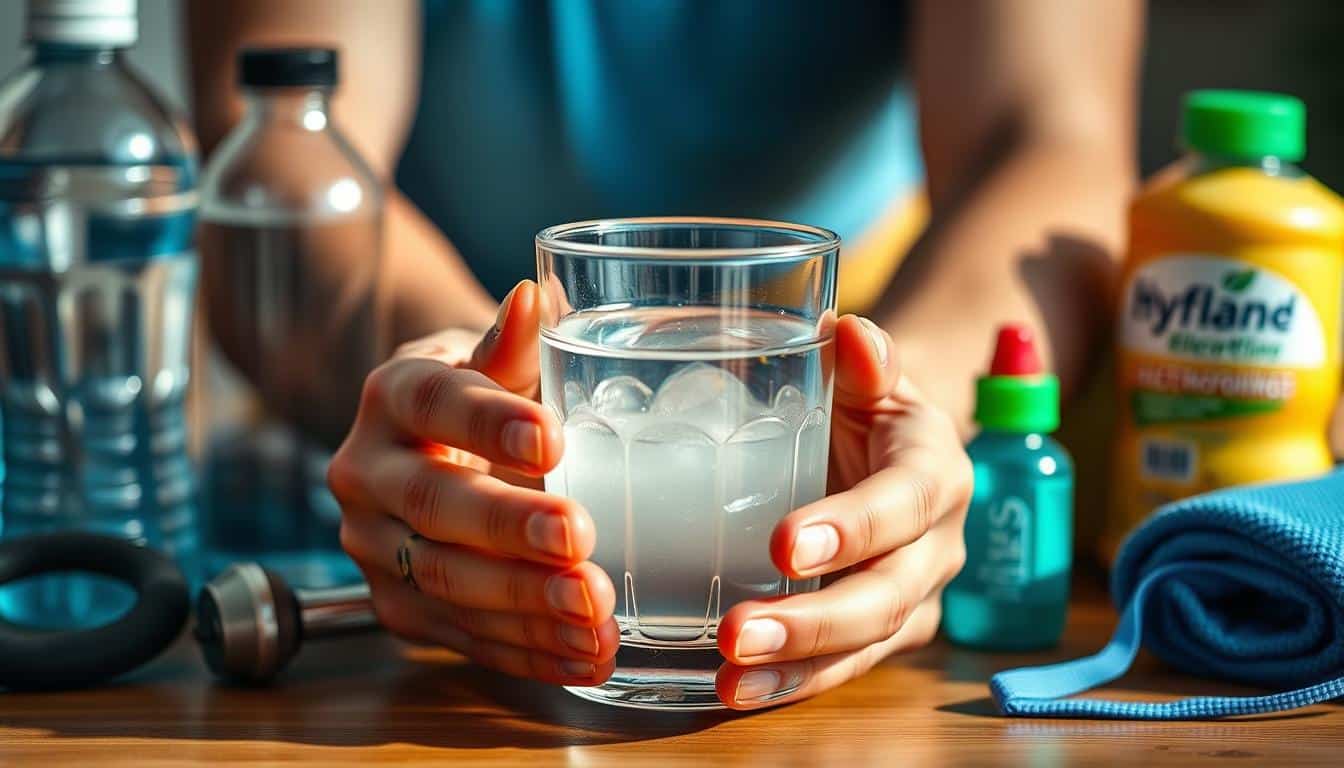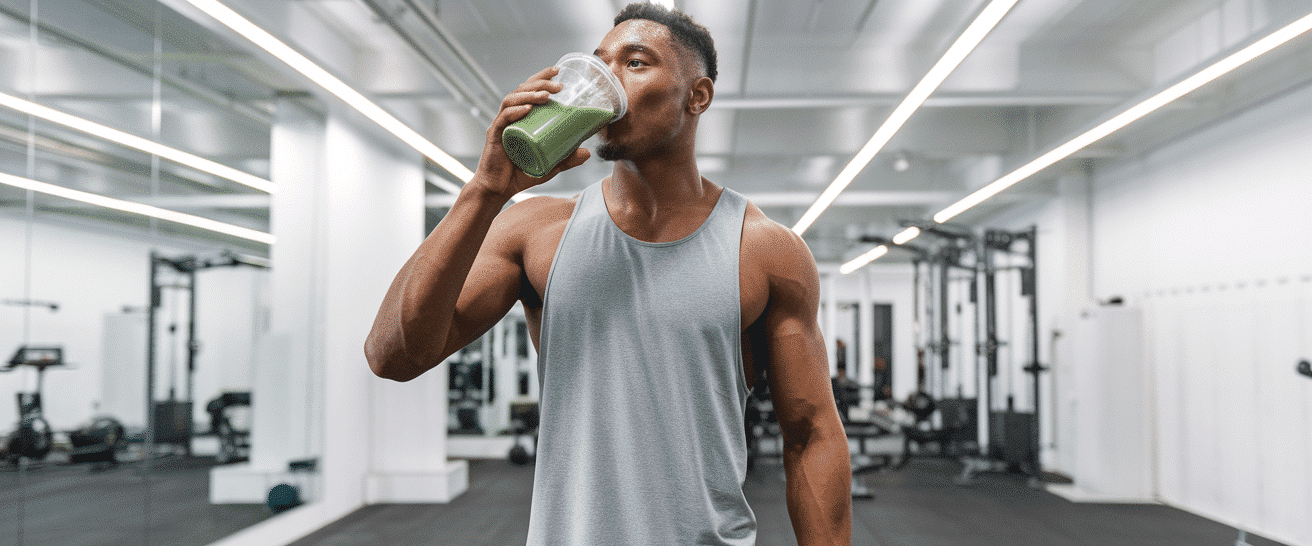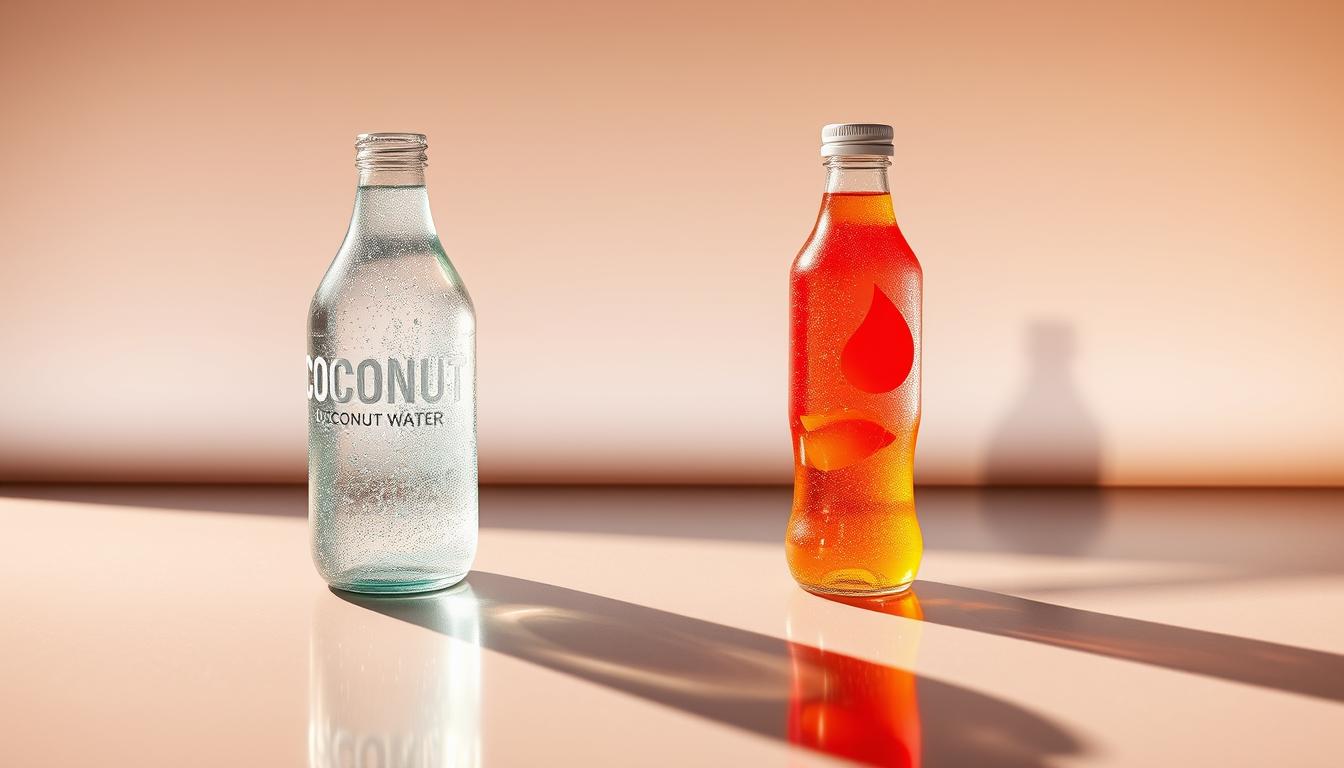Did you know one natural drink packs 10x more potassium than popular electrolyte beverages? Research shows both options hydrate athletes equally well during intense workouts. But their nutritional profiles tell different stories.
A recent study tested cyclists using either option during endurance rides. Results? No difference in performance. Yet one choice delivers 1420 mg/L of potassium—over 10 times the amount in standard sports formulas. That’s more than a banana’s worth in every liter!
You might wonder: Does this mineral boost matter? For most workouts under 90 minutes, either drink works. Longer sessions? The natural option’s electrolytes could help prevent cramps. We’ll break down how each supports hydration, energy, and recovery.
This isn’t about declaring a winner. It’s about matching your needs. Some prefer the light sweetness of nature’s offering. Others want the precise carb ratios in engineered formulas. Your goals and taste buds decide.
Let’s explore what science says about these hydration heroes. You’ll learn when each shines and how to choose based on your activity level. Ready to upgrade your workout routine?
Introduction to Beverage Comparison
In the world of fitness, what you drink is as crucial as how you train. The global market for electrolyte-rich beverages is booming, projected to hit $36 billion by 2028. Why? Because active individuals lose up to 12 grams of sodium during extreme events—equivalent to 7-8 liters of sweat.

Context and Relevance
More fitness enthusiasts now seek natural options over lab-made formulas. This shift reflects growing awareness about ingredients—people want fuel that works with their bodies, not against them. The trend isn’t about rejecting science, but balancing engineered solutions with nature’s offerings.
Purpose of the Comparison
We’re cutting through the noise to show what matters for your routine. Whether you’re lifting weights or training for a marathon, your drink should match your effort. Below breaks down key differences:
| Nutrient | Engineered Formulas | Natural Option |
|---|---|---|
| Sodium | Added for fluid retention | Low levels naturally |
| Potassium | ~100 mg/L | 1420 mg/L |
See the gap? One’s designed for quick sodium replacement, the other delivers a potassium punch. Your choice depends on workout intensity and personal needs. Next, we’ll explore how these differences impact real-world performance.
Understanding Hydration Needs
Staying properly hydrated isn’t just about drinking—it’s about understanding what your body loses. During exercise, you shed fluid through sweat faster than you might realize. This isn’t just water—it’s electrolytes like sodium and potassium that keep muscles firing smoothly.

Losing 2% of your body weight in fluid can reduce performance. Imagine carrying a backpack that gets heavier as you dehydrate. Your heart pumps harder, muscles cramp easier, and focus fades. Hot weather or intense conditions accelerate this process.
Endurance activities magnify these effects. Studies show losing over 4% of body mass risks serious dehydration issues. Blood volume drops, making your cardiovascular system work overtime. You’ll feel like you’re running through mud—even if you’re well-trained.
The solution? Replace what you lose before it becomes a problem. For workouts under an hour, plain water often suffices. Longer sessions? Prioritize drinks with electrolytes to match your sweat losses. Your body will thank you with better stamina and quicker recovery.
Nutritional Profiles of Each Beverage
What’s really in your post-workout drink? Let’s compare their building blocks. Both options deliver hydration, but their nutrient packages tell different stories. You’ll want to match these details to your sweat levels and energy demands.
Essential Minerals and Vitamins
The natural choice shines with potassium—250mg per 100g versus 45mg in engineered formulas. That’s enough to cover 12% of your daily needs in one serving. You also get small amounts of calcium and magnesium, which support muscle function.
Lab-made options prioritize sodium (160mg per 12oz) for fluid retention. This helps during marathon sessions where sweat loss exceeds 2 liters. Neither drink provides significant vitamins, but some brands add B vitamins for energy conversion.
Fuel Source Differences
Carbs separate these options dramatically. One cup of the natural drink offers 15g carbohydrates from simple sugars. Engineered versions pack 36g in a 20oz bottle, often using added sweeteners for quick energy spikes.
| Nutrient (per 8oz) | Natural Option | Engineered Formula |
|---|---|---|
| Potassium | 600mg | 120mg |
| Sodium | 105mg | 220mg |
| Carbs | 15g | 21g |
| Sugars | 8g (natural) | 34g (added) |
See the trade-offs? High-intensity athletes might need the sodium and carb boost. For moderate exercise, the mineral-rich choice prevents nutrient gaps without sugar overload. Your sweat rate and goals decide which profile fits best.
Focus on coconut water vs sports drinks: Key Differences
The battle for workout hydration comes down to mineral math. While both options replenish fluids, their electrolyte composition tells contrasting stories. Think of them as different tools for distinct jobs—one’s a precision wrench, the other a multi-use hammer.
Mineral Showdown
Let’s break down the numbers. The natural choice delivers 10x more potassium than engineered formulas—1420 mg/L versus 132 mg/L. This mineral helps regulate muscle contractions and nerve signals. But sodium levels? They’re nearly identical at 448 mg/L vs 458 mg/L.
Why does this matter? Heavy sweaters lose more sodium through perspiration. Engineered options prioritize replacing this key electrolyte. The natural alternative’s potassium boost better supports moderate exercisers who need cramp prevention without excessive salt.
| Nutrient | Natural Source | Engineered Formula |
|---|---|---|
| Potassium | 1420 mg/L | 132 mg/L |
| Sodium | 448 mg/L | 458 mg/L |
Your body processes these differences uniquely. Lab-made drinks use synthesized minerals for rapid absorption during marathons. Plant-based electrolytes work gradually—ideal for yoga sessions or casual cycling. Match the source to your sweat rate and goals.
Electrolyte Composition for Optimal Hydration
Your hydration strategy hinges on two key minerals working in harmony. Sodium and potassium act like teammates—one keeps fluids in check, the other ensures muscles fire properly. Getting their balance right makes all the difference during workouts.
The Dynamic Duo Explained
Sodium acts as your body’s fluid manager. It helps retain water, especially during long sessions where sweat pours out. Athletes lose about 1-1.5 grams per liter of sweat—that’s why many drinks prioritize replacing this mineral first.
Potassium plays defense against cramps. It regulates muscle contractions and maintains cell fluid balance. Though you lose less (about 6 mmol/L vs sodium’s 40 mmol/L), shortages can disrupt nerve signals and energy production.
| Mineral | Role | Sweat Loss |
|---|---|---|
| Sodium | Fluid retention | High |
| Potassium | Muscle function | Moderate |
Engineered formulas excel at rapid sodium replacement—critical for marathoners or heavy sweaters. Natural options counterbalance with potassium-rich profiles, ideal for moderate exercisers preventing fatigue. Your sweat rate and workout length determine which ratio works best.
Remember: Electrolytes team up to power your performance. Match their levels to your effort, and you’ll stay energized from warm-up to cool-down.
Performance Impacts on Endurance and Recovery
When pushing your limits, every second and every watt matters. A study of 19 cyclists revealed something surprising: their 20km time trial results stayed nearly identical whether they chose natural or engineered hydration. Let’s explore what this means for your training goals.
Effects on Time Trial Performance
Researchers measured cyclists’ efforts down to the second. Those using the natural option finished in 2,863 seconds, while others with engineered formulas clocked 2,892 seconds. The 29-second gap? Statistically insignificant.
Power output told the same story. Riders averaged 208 watts with one drink and 204 watts with the other. Whether sprinting hills or maintaining pace, both groups delivered comparable intensity.
| Metric | Natural Beverage | Engineered Formula | Effect Size |
|---|---|---|---|
| Time Trial Duration | 2,863±467s | 2,892±477s | Trivial |
| Average Power | 208±58W | 204±60W | Trivial |
Recovery Metrics Comparison
Post-ride recovery showed minimal differences too. Muscle soreness levels and heart rate normalization rates matched closely between groups. Your body’s bounce-back ability depends more on consistent hydration than drink type.
For endurance activities under 3 hours, both options kept athletes equally fueled. The key takeaway? Choose what you’ll actually drink regularly—your performance depends on hydration habits more than brand labels.
Review of Research Studies on Beverages
Science cuts through the hype around workout hydration. Over the past few years, multiple studies have tested natural and engineered options head-to-head. Their findings might surprise you.
How Researchers Tested Hydration
Scientists used smart methods to ensure fair comparisons. In one trial, 19 cyclists rode for 90 minutes followed by a 20km race against the clock. Another study had 12 athletes run on treadmills until dehydrated. Both groups tried each drink in random order—a “crossover” design that cancels out personal differences.
What the Numbers Reveal
Results showed nearly identical performance across both beverages. Cyclists’ race times differed by less than 30 seconds—a gap smaller than typical day-to-day variations. Runners regained hydration equally fast regardless of their drink choice.
The American College of Sports Medicine confirms both options work for different needs. Whether you’re training for competition or staying active, these studies prove your body adapts well to either choice. Focus on what tastes better and fits your routine—science backs your preference.
Practical Implications for Athletes
Your workout success hinges on smart hydration choices. Let’s translate research into real-world strategies that fit your routine. The best option isn’t universal—it’s personal.
Tailoring Your Fluid Strategy
Short, moderate sessions under 90 minutes? Reach for the natural choice. You’ll get essential minerals without unnecessary calories. Studies show it maintains performance as effectively as engineered formulas during yoga, casual cycling, or strength training.
Facing a marathon or HIIT session? Prioritize drinks with higher sodium and carbs. These support intense efforts where sweat loss exceeds 2 liters. Heavy sweaters particularly benefit from this approach—their bodies crave rapid electrolyte replacement.
| Activity Type | Duration | Optimal Choice |
|---|---|---|
| Weightlifting | 45-60 mins | Natural electrolyte source |
| Triathlon Training | 2+ hours | Engineered formula |
Three key factors should guide your intake:
- Clock your sweat: White streaks on clothes? You need more sodium
- Check duration: Beyond 90 minutes? Boost carb intake
- Listen to cravings: Your body often signals what it needs
Both options deliver benefits when matched to your exercise demands. The right choice keeps you energized without digestive stress. Trust your instincts—what works during practice will shine on race day.
Comparative Hydration Mechanisms during Exercise
Ever wonder why some drinks keep you going longer during sweat sessions? Your cells use clever tricks to absorb and retain what you consume. Let’s explore the science behind staying fueled without frequent bathroom breaks.
Absorption Speed and Retention Rates
Both popular options beat plain H₂O in hydration efficiency. Research shows cyclists lost 1.2-1.3 liters of sweat during 90-minute rides but maintained 70% fluid retention with either drink. Your intestines work smarter with help from natural sugars or engineered carbs.
| Metric | Natural Option | Engineered Formula |
|---|---|---|
| Fluid Retention | 71% | 69% |
| Net Deficit Post-Workout | 0.2L | 0.3L |
| Absorption Time | 15-20 mins | 10-15 mins |
The natural choice uses fructose to pull water into cells gradually. Lab-made versions combine glucose and sucrose for faster uptake during intense efforts. Both methods help you retain 2-3 times more fluid than drinking plain water alone.
After exercise, your kidneys manage either option effectively. Studies show similar recovery rates for blood volume and electrolyte balance. Choose based on your activity’s demands—quick fuel needs versus sustained mineral support.
Nutrient Absorption and Energy Provision
Your muscles need fuel, but how they get it matters more than you think. The natural beverage delivers carbs through simple sugars like glucose and fructose. These enter your bloodstream steadily, providing consistent energy for moderate workouts. Engineered formulas use processed sugars designed for rapid uptake—ideal when you need quick fuel bursts.
Research shows both options power workouts under two hours effectively. One trial found a 16% energy difference between them—1164 KJ versus 970 KJ. Yet athletes performed equally well in time trials. Why? Your body prioritizes carb availability over total energy content during shorter sessions.
| Metric | Natural Beverage | Engineered Formula |
|---|---|---|
| Energy (KJ) | 1164 | 970 |
| Carbs per serving | 15g | 21g |
Absorption speed becomes crucial past the 90-minute mark. The natural choice’s slower release helps maintain stamina during long hikes or cycling events. Lab-made drinks shine in sprints or HIIT where immediate energy matters most.
Your digestive system reacts differently to each option. Natural sugars blend with electrolytes for smooth processing. Some synthetic blends might cause sloshing if consumed too quickly. Listen to your body’s signals—comfort impacts performance as much as nutrient profiles.
Scientific Analysis of Fluid Loss and Replacement
Your sweat tells a story your workout playlist doesn’t. Every drop contains clues about what your body needs to recover. Let’s decode those salty streaks and match them to smart hydration choices.
Sweat Science Made Simple
Heavy sweaters lose up to 3 grams of sodium per hour—enough to season a plate of fries. That’s why some athletes crave salty snacks post-workout. Your drink should mirror these losses. Lab-tested formulas excel here, packing 40% more sodium than natural alternatives.
But don’t overlook potassium. This silent partner helps muscles relax after contractions. Moderate exercisers often benefit more from its cramp-fighting power. Research shows casual gym-goers replace potassium 3x faster than endurance athletes replenish sodium.
Your ideal strategy? Check your shirt post-workout. White salt rings mean prioritize sodium-rich options. Minimal residue? Focus on potassium sources. Both approaches prevent that post-exercise “zombie mode” by restoring what you’ve literally poured into your workout.
Remember: There’s no universal answer—only what works for your unique biology. Whether you’re drenched after spin class or slightly glowy from yoga, smart fluid replacement keeps you performing at your peak. Listen to your body’s signals, and you’ll always win the hydration game.


